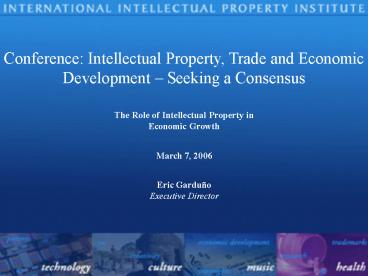The Role of Intellectual Property in Economic Growth PowerPoint PPT Presentation
1 / 15
Title: The Role of Intellectual Property in Economic Growth
1
Conference Intellectual Property, Trade and
Economic Development Seeking a Consensus
The Role of Intellectual Property in Economic
Growth March 7, 2006 Eric Garduño Executive
Director
2
- About IIPI
- A non-profit, non-governmental organization
- Promotes the idea that intellectual property is a
tool for economic growth - Works to improve the use enforcement of
intellectual property around the world - Efforts including raining, research, and
technical assistance
3
What is Innovation?
- The ability of a country to create and absorb new
- technology, and implement such technology into
- economic production.
4
Economic Growth and Innovation
Source World Bank, Maloney 2003
5
Economic Growth and Innovation
- Total Factor Productivity (TFP) Efficiency of
inputs - More than half of growth rate disparities
between countries are the result of differences
in the efficiency of using of inputs as opposed
to endowments (resources, capital, labor) - Technological innovation drives the productivity
of labor, a key input (Solow 1956, 1957) - Many believe innovation dominates changes in TFP,
more so than the accumulation capital for
example - Since the second half of the 19th century, THE
major source of economic growth in the developed
countries has been science-based technology -
Stanley Kuznets
6
Economic Growth and Innovation
- Exogenous (Solow) v. Endogenous (Arrow)
- Technological Change
- Exogenous constant, unaffected by factors within
the given economy - Endogenous dynamic, dependent on specific
activities
7
Economic Growth and Innovation
- Exogenous (Solow) v. Endogenous (Arrow)
- Technological Change
- Effective property rights protections and
learning-by-doing (Arrow 1962) are two factors
that affect the rate of technological change. - Learning affects the diffusion of new technology,
which displays increasing returns to use - Property rights create incentives to produce new
technology - Thus, the rate of technological change can be
affected by specific institutions and activities
within the economy.
8
Intellectual Property and Innovation
- Yale Evenson (2001)
- Research Question Do IPRs spur technological
change within a given market? - 30 countries
- IPR strength index
- Technological change is proxied by RD/GDP ratio
- Conclusions
- Correlation shows unambiguous significance of
IPRs in encouraging RD investment expenditure. - Countries with stronger IPRs invest a greater
percentage of their GDP in RD than countries
that do not.
9
Intellectual Property and Innovation
- Mansfield (1994)
- Research Question Do IPRs attract foreign
technology inflows via FDI? - Survey/Interview based research
- Conclusions
- Perceived IPR strength has a substantial effect
for FDI inflows. - The effects are particularly strong for
particular industries with highly sensitive
technology, such as the chemicals and
pharmaceuticals industries. - It is also true that within industries, the
transfer of the newest technologies are less
likely if there are few IPR protections.
10
Intellectual Property and Innovation
- Park and Lippoldt (2004)
- Research Question Do stronger IPRs increase
international technology - transfer flows via licensing specifically?
- Aggregate Data and Firm Level Data
- Indices of IPR strength
- Focus on licensing activities
- Licensing indicates true transfer of technology
(uncontrollable as opposed to controllable
assets like FDI and joint ventures) - Greater threat of piracy with licensing
- Conclusions
- Overall, the analysis presented here indicates
that where developing countries have moved to
address weaknesses in these areas in recent
years, they have tended to experience enhanced
access to technology through licensing.
11
Intellectual Property and Innovation
- IBRD Maskus (2005)
- Research Question How do IPRs affect arms-length
licensing? - 23 countries
- Use Parks index of IPR strength, correlate with
US MNEs licensing fees - US firm data from US Department of Commerce
- Conclusions
- US receipts of unaffiliated royalty and licensing
fees increase with the IPR strength of the
technology recipient country - Patents promote arms-length technology trade
12
Effective IP Policies
- Establish intellectual property laws that support
industry - Provide effective administration and enforcement
of IPRs so that industry can rely on the rights
they are granted - Implement policies that help companies use IP to
establish competitive advantages
13
What is Innovation?
- The ability of a country to create and absorb new
- technology, and implement such technology into
- economic production.
14
Effective IP Policies
- Patent Intelligence Kenya
- Public-to-Private Technology Transfer South
Africa/Brazil/India - Brand Creation and Effective Management
Colombia - Compensation for Performance Royalties - Jamaica
15
- Thank You
- Eric Garduño
- Executive Director
- International Intellectual Property Institute
- egarduno_at_iipi.org

